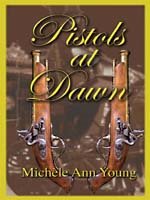Wednesday, August 30, 2006
Contest Musings
I honestly believe that contests are not a bad thing.
Well that was a bit mealy-mouthed. What I mean is, they can be a good thing as long as you approach them properly.
The first contest I entered frightened me to death. I got below average scores and I got comments. I could not read the comments. I was scared s**tl**s when I saw the scores. As it turned out they were right -- but it took me a good while to understand them being a newbie and all.
But the whole thing was a shot in the you know where. That was when I joined RWA and started to go to workshops and to read craft books and so on. Now, I don't think contests are an end in themselves. If you are one of the lucky ones who gets bought from a contest, more power to you -- it doesn't happen often. As can be seen from American Title 2, only one of us sold from that contest, but the rest of us gained new friends and a lot of exposure.
But I also see contests from the other side. As part of my gift back to the cause, I try to judge two or three contests a year, with the hope of helping others as I have been helped. It is sometimes a two edged sword.
Are you to be honest? Or do you try to save the person's ego.? The thing with judges' comments, no one but you has to see them and if the judge really wants to help you, then he or she should be brutally honest. That is what an editor is going to be. Not destructive, of course, or personal, but if you can identify what you see as good or more importantly what you see as a problem, giving the contestant a chance to fix it, surely that is better than an average score and a pat on the head?
I think if you are too constructive, the contestant can miss the point. If you say really nice things and give a low score, that is confusing. Finding a balance in the heat of the urge to be helpful is not always easy.
Why post about this. Well, I received a thank you note, which smacked very much of bad you and poor me and here are all my personal problems. Quite honestly, I had trouble remembering the entry, though I did keep the score, which was probably one of the lowest I have ever given.
Now I'm feeling bad.
Would I have been better to say this is almost publishable, I love your hero and heroine, when they really needed lots of work and I spent quite a bit of time trying to explain why?
Second guessing is bad. Feeling guilty is bad. Is trying to help someone improve, bad? Was I too harsh by being frank? I'm not sure. Will I judge again? Yes. If I can say one thing that will help one other person get published, even if none of the others are helped, then I think the work will have been worth it. Otherwise, why am I taking time out of my writing?
Fortunately I have up to now always recieved very appreciative thank you notes. I have to remember that too. And, I will review the judging I am doing right now to make sure my frankness is as friendly as possible -- but honest. After all, we can all benefit from a critique.
Now I have that off my chest, I am off to find a glass of Chardonnay. Have a wonderful Labor Day weekend even if Ernesto does try to drown us.
Tuesday, August 29, 2006
Duelling - Part II

Many apologies for this late post for all you out there waiting with bated breath.
Got hung up on Prison Break last night and completely missed the boat. God, those men are either total hunks or absolute freaks.
Note: If you want to read Pistols at Dawn - Don't forget you can ask your library to order a copy for you.
Back to Duels
Duels had to be the forerunner of the cowboy shootouts, although there is someone out there saying these are a figment of Hollywood imagination. All I can say to that is, where is the romance in your soul!
Duels had rules. Gentlemen just love their rules, don’t they?
Think boxing, football, basketball. They all involve strict sets of rules and winners and losers. Heavens to Prinny!These are the modern day duels.
Perhaps one of the most important rules of dueling does not involve the mechanics of the duel itself, but rather who is allowed to duel. Dueling was the sport of the nobly born.
Of course, there were all the expected rules about distance and choice of weapons and even what kind of insult required what kind of result – wounding or death. Great choices, my dear, especially when with the state of medicine, any kind of wound could result in death. The French had 84 individual rules and the Irish rules, which were the rules most commonly used in most of Europe had 25 or so. If you check my website you will find a link to all of them.
Apparently the Germans continued a form of dueling long after everyone else had more or less given it up in favor of cricket (at least in England).
Other rules. One was not supposed to challenge a young man who was not of age nor to duel with him , if he challenged you. Also one was not supposed to challenge an aged or crippled person. Point of honor and all that stuff. Everyone else was fair game.
There are documented cases of women engaging in duels, usually with men. There is one famous case of a French opera singer named La Maupin who reportedly dealt singled handedly with a whole tavern full of men. There is a story in their somewhere.
Duels were also fought with swords and I will talk more about the gentlemanly sport of fencing next week. And will have some more pictures too.
Wednesday, August 23, 2006
Death or Honor - The Art of Duello
 Yes, dueling was indeed still going on in the Regency even though it was illegal and if you were caught, you were tried and so were your seconds..
Yes, dueling was indeed still going on in the Regency even though it was illegal and if you were caught, you were tried and so were your seconds..
Peers could be tried in the House of Lords and non-peers in regular courts. Several times the survivor was not charged when everyone testified that it had not been cold blooded murder but a duel and that all the rituals of the duel had been followed. It really depended on the magistrate
Because of the danger of arrest by a passing constable, duels were often taken out into the country, as it was then. Chalk Farm was cited as a favorite spot, as was Primrose Hill and Westbourne, which are now of course within London. However, duels did also take place in Hyde Park and of course always at dawn.
The most famous American duel was Alexander Hamilton dueling with Aaron Burr above, though I gather they were routine in the Missouri Basin for settling political disputes. Hamilton met Burr in Weehawken, New Jersey, on July 11, 1804, and fired pistols at each other simultaneously. Burr's shot hit Hamilton, while Hamilton shot into the air. There is speculation that he fired that way intentionally so as not to hit Burr, though some think his shot was thrown off when he was struck by Burr's bullet. Hamilton died the next day.
Lord Byron, yes that gorgeous wickedly famous poet, was actually tried in the House of Lords for dueling.
The Duke of Wellington (who you met and failed to identify in an earlier post) fought Lord Winchilsea a political opponent against catholic emancipation at Battersea Park in 1829 over heated words in the House of Commons. Neither man was hurt, but honor was deemed satisfied. Wellington and fought a duel in Battersea Park in March 1829. The two deliberately missed each other in firing, and honour was satisfied.
And then there were the rules. I will talk more about them and the weapons of choice next Tuesday.
In the meantime I will post some more links to this topic on my website.
Monday, August 21, 2006
The Pantiles or Where the Duke Slipped........
A: Needless to say I am very glad you asked that, because I looked it up. Apparently, and I had this from the very best of sources, my dear (she says in a low voice behind her fan), in 1698 the Duke of Gloucester fell on the slippery ground near the Springs and Princess Anne – later Queen Anne, gave One Hundred Pounds to pave the Walks with pantiles, which are small clay tiles. These tiles were laid on the Upper and Lower Walks to allow the rich and famous to walk in safety. Sad to say the Walks were repaved with flagstones in 1793. But for those intrepid researches who really need to see a small square tile, you can do so at the Tunbridge Wells Museum.
I should also note that because the weather in England in summer is not always fair and dry, (talk about state the obvious) the Pantiles were lined with covered colonnades, so the ladies and gentlemen could take the waters, promenade and stay dry.
At the corner of the Lower Walk sits the Musick Gallery, from where musicians would have entertained the strolling gentry.
 It was moved from the edge of the Upper Walk to its present location in th 1850’s. It’s beautiful bowfront lower window and curved balcony are quite charming.
It was moved from the edge of the Upper Walk to its present location in th 1850’s. It’s beautiful bowfront lower window and curved balcony are quite charming. We had a nice lunch at the Duke of York, pictured here. A pint of local brew and fish and chips.
We had a nice lunch at the Duke of York, pictured here. A pint of local brew and fish and chips.Another fabulous old building to be viewed while walking in the Pantiles. And the name of the little street, Pink Alley, isn't that a wonderful name?

Q: Was that it for entertainment.? Walking back and forth in front of the springs listening to Music?
A: Ah my dear, remember the old days where simple pleasures satisfied all? Royal Tunbridge Wells was much like any watering place in summer in England during the Regency. People went to Assemblies which were by subscription; they entertained each other in their summer homes and they played cricket on the common. There was also a nearby race course – horses that is.
I should mention, that by the time of the Regency, the really fashionable people did not go to Tunbridge Wells. Most of ton went to Brighton or Bath. But the Town still had it’s aficionados and hence my heroine ended up there for one night.
The information in these two is far more than I needed to know for my novel, but I must say that I enjoyed the visit.
There are also a great many interesting places to be found nearby Tunbridge Wells. If you’ve a fancy for castles there are two or three, there’s the ruins of a medieval Abbey, and a multitude of estate homes and picturesque villages.
I hope you will join me in a ramble around some of them over the next few months.
Thursday, August 17, 2006
Royal Tunbridge Wells by Michele Ann Young
In 2004, during my annual research visit I renewed my acquaintance with this ancient town. I hope I have thought of the questions you might feel inclined to ask.
Q: Why is it called Royal Tunbridge Wells?
A. As you may know, our ancestors were very sure that mineral water that tastes nasty has great restorative powers. It often tastes, smells and looks revolting because it contains iron (and sometimes ugh sulpher), and as all you ladies know, iron actually is good for you. I prefer mine in Guinness I must say.
In 1606 Dudley, Lord North discovered the Chalybeate Springs and decided it was health giving. He told his friends. And they told their friends (no telephones or websites) and visitors from London flocked to the village beside the springs. Royalty were regular visitors, starting with Queen Henrietta Maria, mother of King Charles II through to Queeen Victoria.
This picture is a view of the Bathhouse and the Chalybeate Springs which were originally in the middle of a field and gradually became more and more enclosed until it looked like this in 1804.

The Town received its royal prefix from King Edward VII in 1909.
Q: So if it called Royal Tunbridge Wells in a Regency Book, that would be an error?
A: Bows. Indeed, Madame. ——Bit of the old Beau Nash there, ducks.
Q: I thought people went to the City of Bath to drink the waters?
A: Correct, and in time Bath became the more fashionable place. Richard “Beau” Nash, the arbiter of polite society in the 1740’s, also became Master of Ceremonies for Tunbridge Wells. The Town under the auspices of its various patrons continued the tradition into Queen Victoria’s times. So even in the Regency, Tunbridge Wells gave Bath a run for its money and some very famous people continued to visit there because it was so close to London.
Q: Are the original springs still there?
A: Yes. And you can taste the water, if you are brave enough. Been there and done that. Hmm. Must get a teeshirt.
This is a picture down the length of the pantiles, which surround the springs, named after the tiles on the promenade. More about that next time.

Q: Where is Royal Tunbridge Wells?
A: It is a one hour drive from London, in Kent, very close to the Kent Sussex Border. I actually thought it was in Sussex for a while. For more pictures, go to my website and click on My Regency World.
Q: Are there other sites of interest besides the Springs?
A: I am so glad you asked that question, because that will be the topic of my next blog on Tuesday, August 22, 2006
If you have any comments, questions or information to add, don’t be shy. I would love to hear from you.
Monday, August 14, 2006
Pesky Peerages
Confused? Well the question certainly had the regency chapter of RWA (Beaumonde) scratching is virtual head for some weeks. Of course, you call them both Lady Whatever when you introduce them to another person, but it seems to me the jury is out as far as what to call them when they are both in the same room.
Since most of us will not be meeting members of the aristocracy over the next couple of weeks I don’t suppose you really need to know that you address a Duke or a Duchess as "your grace" or that the wife of an earl is a countess not an earless. Umm, sounds more like an earwig.

This is a picture of a very famous Duke. Can you can guess who it is?
He appears in my American Title 2 finalist novel. One day I hope you will meet him there.
However, if you are reading a Regency — or a novel about some other time period if you must — it is helpful to know what the author is talking about and what position the person holds in relation to others.
There are lots of websites who have wonderful details on the ins and outs of the complexities of the British Peerage so there is no sense in my duplicating them here. If you want to wander through the brambles of those terrible titles, trot to my website and under “Favorite Links” under the heading of Pesky Peerages you will find some places to visit for more information.
The next blog in this series will be posted on Thursday, August 17, when I will be describing my rambles around Royal Tunbridge Wells.